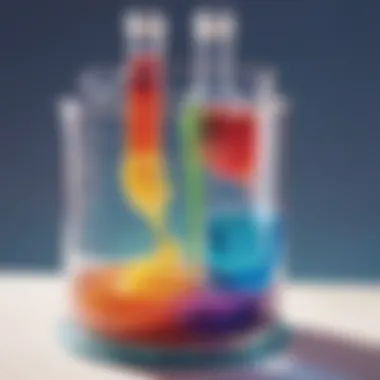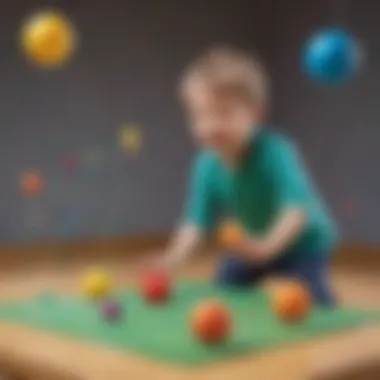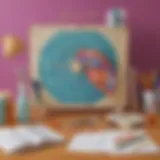Engaging Children with Simple Experiments for Learning


Intro
In recent years, there has been increasing acknowledgment of the importance of hands-on activities for children's learning. Simple experiments stand out as perfect vehicles for children’s engagement and world exploration. Educators and parents can use these activities to foster invaluable skills such as creativity, critical thinking, and scientific reasoning. As technology occupies much of our daily lives, exploring alternative ways to curious minds through tangible experiences becomes even more essential.
These experiments require little otherwise materials and can be executed easily at home or in classrooms. Through participatory learning methods, children can have fun while absorbing lessons in concepts like cause and effect, measurement, and observation. Understanding the need for such experiential learning lays the foundation for structuring purposeful and enjoyable activities. Below, we commence with fun activity ideas that are tailored to boost both enjoyment and educational value.
Fun Activities Ideas
Simple experiments and activities can stimulate interest and encourage creativity. Below are several categories which offer diverse experiences.
Indoor Activities
Indoor environments provide ample instances for sensory stimulation and engagement. Activities like making homemade slime or growing crystals through sugar or salt solutions serve simple yet fascinating avenues to introduce kids to basic chemistry. Here, clear instructions and supervision are key. Letting kids experiment with colors or glues crafted feels rewarding and fun.
Outdoor Adventures
Nature is a great classroom. Outdoor experiences like planting seeds and documenting growth, or creating bird feeders from recyclable items are excellent opportunities for lessons in biology and sustainability. Additionally, simple scavenger hunts, focusing on identifying plants or types of insects bring excitement to learning outside and encourages a physical connection with nature.
Arts and Crafts
Integrating creativity with experimental learning is invaluable. Creating tie-dye shirts or homemade soap offers insight into color mixing and chemical reactions. Moreover, construction projects using everyday household items foster problem-solving skills. During these projects, it is significant for children to recognize the building process as part of their experimentation.
Science Experiments
Consider basic experiments like vinegar and baking soda reactions, to provide thrilling visuals galore! Adults can create simple water filtration projects where children see firsthand how cleanliness arises in nature. Understanding light refraction with prisms can give children foretaste of physics and colors.
Cooking and Baking
Engaging children with food allows learning potential disguised in nourishment. Baking a cake presents opportunities to practice measurements, understanding textures, and applying heat. Simple science applies to recipes where yeast causes dough to rise, revealing fascinating facts about biology that intersect with daily life. Ultimately, children often welcome topics involving the delicious aspect of learning.
“Learning by doing, gives lasting impressions.”
Integrating simple experiments as a resourceful language of play offers children profound moments for experimentation. Building upon joy and reinforcement through multilayered approaches enhances creativity while optimizing essential areas of development. More importantly, simple experiments remain a quintessential method to thrust children into safe yet exhilarating realms of learning.
Understanding Simple Experiments
Understanding simple experiments enriches learning experiences for children. They serve as an effective tool for engaging young minds and fostering a rudimentary understanding of scientific concepts. Unlike traditional methods of teaching, these experiments involve active participation, helping children to grasp complex ideas through tactile experiences.
Definition of Simple Experiments
Simple experiments are hands-on activities that often utilize common household materials to demonstrate fundamental principles of science. These may include chemical reactions or physical transformations. For instance, creating a mini volcano using vinegar and baking soda visually showcases the concept of reactions between acids and bases, sparking children’s interest in experimenting.
The overall goal of these simple experiments is not only to impart knowledge but also to fuel a desire to learn more. They provide a practical perspective on theoretical concepts, making the learning process more engaging and less abstract. Hence, simple experiments effectively bridge the gap between theory and practice, which is crucial for a holistic comprehension of various subjects.
Importance of Hands-On Learning
Hands-on learning is an essential component of education that fosters deeper understanding. When children engage in these experiments, they do not merely observe; they actively participate in the learning process.
Here are some notable benefits of hands-on learning through simple experiments:
- Enhances understanding: Engaging physically with concepts helps to solidify complex principles.
- Boosts curiosity: Kids become more interested in exploring and questioning the world around them after performing these activities.
- Promotes memory retention: Active participation aids in better recollection of facts compared to passive learning methods.
"Hands-on experiences are key in helping children learn and retain critical knowledge more effectively."
Ultimately, simple experiments combine fun elements with educational value. They serve to empower children with knowledge, creating a strong foundation for future learning endeavors.


Types of Simple Experiments
Simple experiments serve as the cornerstone of children's educational fun. Understanding the variety of experiments types enables parents and educators to pick approaches that suit learning needs. Each category offers practical insights and aligns with various interests. The segments that follow reveal unique aspects and essential characteristics of several types of experiments.
Chemical Reactions
In the realm of chemical experiments, children engage with dynamic processes. These experiments illustrate basic scientific principles like reaction stages and the resulting consequences. Through captivating methods, kids can observe changes happen in real-time, establishing a firmer grasp of theoretical concepts.
Vinegar and Baking Soda Volcano
The vinegar and baking soda volcano is a classic example exploring chemical reactions. This project creates a tiny eruption as vinegar reacts with baking soda, producing carbon dioxide. It provides profound visual stimuli and captivates children's fascination with cause and effect. As a result, it has become a staple in educator toolkits.
One appealing aspect of this experiment is its simplicity — opening a bottle of vinegar and adding baking soda can create impressive results. However, it’s essential to have adult supervision to manage excitement and any specific mess. The overall advantages include easy execution and complete engagement for kids as they witness explosive reactions.
Making Slime
Making slime combines materials like glue, water, and borax, resulting in a stretchy, thick substance. This activity lets children experiment, transforming plain ingredients into fascinating textures, promoting sensory exploration. As an engaging choice, the activity encourages creativity and independence, allowing kids to tailor viscosity and form.
Fluctuating characteristics of slime entice children to explore various outcomes by adjusting recipes. One downside is the requirement of glue and possibly other sourcing for non-toxic options, though most commonly found materials are useful as well. Overall, it merges science with fun and leaves kids excited about their creations.
Physical Science Experiments
Physical science holds great prominence in demonstrating laws of physics and fundamental concepts. Children delve into exploratory learning, understanding concepts of force, motion, and energy in tangible actions.
Balloon Rocket
A balloon rocket uses air pressure to launch a lightweight balloon tethered to a string. Children can grasp propulsion, jet dynamics, and horizontal motion by very practically observing how air expulsion propels the balloon forward. It’s beneficial because kids not only learn by doing, but they can experiment with different variables like string orientation and balloon sizes, enhancing critical thinking.
While this experiment is often unsuccessful the first time, each failure paves the way for valuable lessons emphasizing problem-solving and innovation. An advantage is how achievable and inexpensive it is while needing items easily sourced at home, though children may need adult assistance to manage tension.
Homemade Compass
Creating a homemade compass leads children to be curious about Earth’s magnetic fields. Using an ordinary needle, a magnet, and a container filled with water, they can create a functional tool guiding them on directionality. This promotes geographical awareness as they comprehend Earth's properties.
It is particularly valuable since learners can physically interact with the object they created. Moreover, it merges science with artistic elements, boosting balance between analytical and creative processes. A limitation could be the varying precision depending on tools available; however, the benefits of understanding navigation ease that out.
Biological Experiments
Biological experiments channel children's interest in nature. By exploring living systems, kids can foster an appreciation for growth, sustainability, and responsible practices in their surroundings.
Germination of Seeds
Germination of seeds allows children to observe the lifecycle firsthand. Utilizing common substances such as pots, soil, and seeds of their choice shifts focus towards botany right at home. It teaches them agricultural practices while tasting knowledge in nurturing and growth.
This specific experiment can also weave threads of responsibility, as students care for living entities. Its benefit transcends purely academic knowledge, encouraging emotional engagement toward environmentally friendly practices. Limited timeframe for visible results may minimize patience in some children, yet the rewards of achieving leafy outcomes can teach profound lessons in persistence.
DIY Terrarium
Creating a DIY terrarium transforms an empty vessel into a miniature ecosystem, combining plants, soil, and decorative elements of choice. This enables children to experiment with various plant types, soil compositions, and designs. Interacting gives a joyous connection to sustaining natural worlds and helps solidify ecological principles.
A notable strength is the long-term engagement it offers. The terrarium acts as a living example encouraging children to regularly observe patients and metrics of growth. downside incldes any possibility of plants dying, causing discouragement if caretaking efforts do not yield positive results. Nevertheless, the age-tested nature of this experiment aids in pushing overall educational goals forward.
Environmental Experiments
Of equal significance, environmental experiments extend kid's learning into broader contexts. Uncovering relationships within ecosystems nurtures awareness and stewardship.


Water Filtration Method
The water filtration method involves using common materials like cotton, sand, or charcoal to design an effective filtration system. It teaches the principles of contamination and purification processes in real-world applications, shaping an awareness of basic water management.
Notably, it provides children with a hands-on approach to understanding eco-friendly practices and potential solutions for real-life issues. A drawback list involves children potentially mishandling materials which causes unsanitary setups without adult guidance. Amidst that risk, promoting such experiments sparks discourse in conservation and sustainable practices.
Building a Birdhouse
Constructing a birdhouse engages children in woodworking while fostering a love for wildlife. Kids witness asymbiotic relationships acted out in their backyards as they attract local birds with a place to inhabit. This project can also integrate responsibilities like maintenance and observation, helpful in internalizing stewardship of wildlife.
Crafting a birdhouse offers versatility; from execution to decor choosing allows for multiple dimensions of creative expression. Its great advantages include problem-solving skills through structural design elements too. Conversely, the complication arises in constructing if children need help, potentially causing frustration. Overall, this project yields organic interaction, opening hobbies related to nature.
All these experiments evoke creativity and excitement. Additional skills in planning, execution, and communication align seamlessly with typical educational curricula. Such experiments enhance children's understanding and relationships with science across all facets of learning.
Execution of Simple Experiments
Engaging children in the process of simple experiments yields numerous benefits. By executing these experiments effectively, children deepen their understanding of scientific principles while having fun. Execution involves several key elements to ensure that the process is safe, enjoyable, and educational. The steps cover gathering the right materials, maintaining safety precautions, and following a structured procedure to complete each experiment successfully.
Gathering Materials
The initial step in executing a simple experiment is to gather all necessary materials. Preparing in advance increases efficiency and keeps the focus on learning. Ensure that the materials are age-appropriate and safe for children to handle.
Some common materials for various experiments include:
- Plastic bottles
- Vinegar and baking soda
- Soil and seeds
- Balloon
- Plastic cups
- Jars for terrariums
Finding items around the house is often convenient. You do not need expensive kits to foster scientific curiosity. It is essential to create a checklist of materials before starting. This not only helps in organization but also allows children to understand what is required for their experiment.
Safety Precautions
Safety is paramount in any scientific endeavor, especially when engaging children. Discussing potential hazards beforehand sets the expectation for careful behavior. Implementing basic safety measures uplifts the overall learning experience.
Some important safety tips include:
- Use gloves when handling materials that may irritate the skin.
- Supervise closely during the experiments, particularly those involving reactions.
- Keep materials away from the face to avoid accidental exposure.
- Educate children about proper handling methods for all materials.
Always be prepared for unexpected situations. Having a first-aid kit nearby is always sensible in any experiment. Taking these precautions ensures an enjoyable learning environment.
Step-by-Step Procedures
Effective execution relies heavily on a clear and detailed procedure. Children benefit from understanding each stage and how it builds towards the outcome. An organized approach enhances the learning process, resulting in a fruitful experience.
To ensure clarity, one can break down the procedures into small, manageable steps. Here is a generic format helpful in tandem with any simple experiment:
- Introduce the Experiment: Explain what will be done and why it is fascinating.
- Prepare the Workspace: Organize materials and clean the area.
- Follow the Steps: Pay attention to each action needed while encouraging children to ask questions.
- Document the Results: Encourage children to record observations.
- Discuss Outcomes: Avoid a conclusion jumping; deliberate thoughts promote cognitive growth.
Applying these steps enables children to trust their abilities. Execution of simple experiments, with the right atmosphere and guidelines, turns learning into both successful and joyful encounters.
Educational Benefits of Simple Experiments
Simple experiments can offer various educational advantages for children. Implementing these experiments helps to create an engaging environment where children can learn valuable skills. By fostering interests in different scientific fields, educators and parents can inspire children to be inquisitive. Furthermore, these benefits create lasting impacts on children’s life and future.
Developing Critical Thinking Skills
Engaging with simple experiments provides children with a platform to hone their critical thinking skills. As they conduct these experiments, they observe outcomes, which naturally leads to question asking. What will happen if I add more vinegar? and Why did the balloon inflate? are just some examples of questions that arise. Navigating through the problem-solving process encourages children to think logically.


Also, explaining results enhances understanding across various subjects. For example, when discussing electricity with a simple circuit experiment, children must analyze the connections and see how changes affect the circuit. This process develops their and teaches them to draw conclusions from their observations. In doing so, they grow into informed thinkers, ready to approach complex subjects critically.
Encouraging Teamwork and Collaboration
Simple experiments often involve multiple children, making them perfect for nurturing teamwork. Whether in a classroom or at home, group settings foster interaction, as children share thoughts and insights. Working together to execute an experiment can teach children how to adults cooperate towards a common goal.
Additionally, it enables them to trust and rely on each other, sharing responsibilities. This cooperation not only wheels, learning experiences become enhanced but creates friendships built during fun explorations. Considering important roles within teamwork, leaders and helpers naturally emerge, thus reinforcing each child's social skills.
Enhancing Problem-Solving Abilities
Simple experiments actively cultivate problem-solving abilities. While errors may occur during experimentation, children learn not to be deterred by setbacks. For instance, if a baking soda and vinegar reaction falls flat, understanding what is missing and making adjustments becomes part of the process. This fosters resilience, showing that failure can lead to new insights.
Children are encouraged to re-evaluate their methods, adjusting ideas to seek successful outcomes. By exploring various approaches to tackle their problems, they develop an arsenal of techniques to address challenges beyond labs or classrooms. Ultimately, gaining experience through simple experiments equips children with practical problem-solving tools.
By performing experiments, children can tap directly into their sense of exploration and curiosity. It expands their understanding of the world through direct involvement.
Incorporating Simple Experiments into Learning Curricula
Incorporating simple experiments into educational curricula has undeniable benefits. These types of activities provide interactive and practical experiences, allowing children to learn through doing, rather than just hearing or reading. Such hands-on involvement cultivates curiosity and motivates students to explore scientific concepts beyond the textbook. They learn actively, fostering a natural interest in science and learning as a whole. There is a distinct advantage to using experiments aligned with educational standards. This alignment ensures that educators and parents can incorporate engaging learning without sacrificing the rigor required in educational settings.
Aligning with Educational Standards
Simple experiments can be designed to meet various educational standards established by different educational bodies. Aligning these activities with standards not only enhances the educational process, but it also makes it easier for educators to integrate experimental learning into their existing curricula. For example, elementary science standards often include inquiry-based learning. Activities like creating a simple battery from lemons or experimenting with buoyancy using different objects allow children to explore the properties of science directly.
Using supports such as lesson plans or state educational guidelines can enhance this alignment. Below are examples for successful integration:
- Incorporate content objectives of general science standards when planning a lesson around chemical reactions.
- Build projects that span different learning standards such as physics, chemistry, and biology through practical experiments.
Creative Ways to Integrate Experiments
There are multiple engaging methods to weave simple experiments into the academic environments. Not every modification needs extensive resources or elaborate setups. Here are some creative ideas to consider:
- Team Projects: Simple experiments work well in teams. Assigners can encourage cooperation among students, ensuring a collective understanding of the concept.
- Family Science Nights: Host events where parents can join students in hands-on activities, fostering deeper engagement from home.
- Adventure Learning: Take students outside. Environmental experiments can merge naturally into outdoor learning experiences.
Experimentation encourages bonding between students and stimulates collaborative learning experiences. These settings are exceptional for word-of-mouth learning and growing partnerships.
Overall, the focus should adhere to the value that incorporating simple experiments enhances education effectively. Teachers and parents hold the power to make learning an enjoyable adventure directly through these experiments.
The End and Future Perspectives
Simple experiments play a crucial role in enhancing child development. Tending to their curious nature with hands-on activities shapes not just knowledge but also interpersonal skills. Understanding how these experiments fit into education helps parents and teachers frame their approach to learning.
Educators using simple experiments can align lessons toward educational standards, thus ensuring both relevance and effectiveness in the learning process. Importantly, these activities sharpen critical thinking and problem-solving skills more than conventional teaching methods.
Experimentation allows children to engage at their own pace. They connect with fundamental scientific concepts and life skills in a tangible manner. Children often remember lessons learned through personal experience rather than mere theory. As hands-on learning excites and inspires kids, classrooms and homes can become fertile ground for innovative thinking and cooperation.
Encouraging a culture of curiosity encourages children to ask questions and seek answers constructively.
Recap of Key Points
- Simple experiments stimulate inquisitive minds and develop critical skills.
- Integration with educational standards enhances lessons while keeping engagement high.
- The connection between experiential learning and way children absorb knowledge cannot be overstated.
- Promoting collaboration through these activities benefits social development too.
These points reflect both the challenges and opportunities presented by simple experiments in children's learning.
Encouraging Continued Experimentation
To cultivate a mindset of exploration, it is crucial to encourage ongoing problem-solving. Communities of learners—whether in classrooms or at home—should continue to experiment.
Here are some ways to stimulate further investigation:
- Set aside regular time: Give kids time to experiment without distractions. A routine provides security and enhances exploration.
- Supporttheir interests: Direct experiments based on children's preferences. Tailoring projects boosts investment and motivates engagement.
- Promote sharing: Create opportunities for them to share findings . When children discuss what they discover, they enhance understanding and instill confidence.
- Document experiments: Suggest keeping a journal of observed results and reflections can deepen comprehension and develop writing skills.
As we promote continued experimentation, we build a foundation not only for knowledge but also for resilience and discovery throughout life. Such skills prepare them for their own future challenges.



